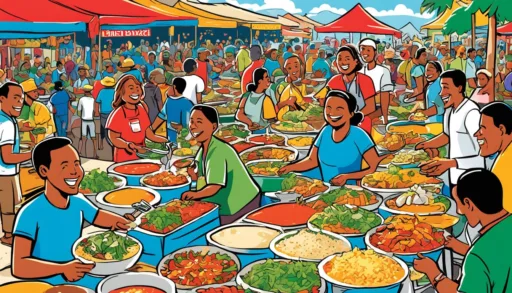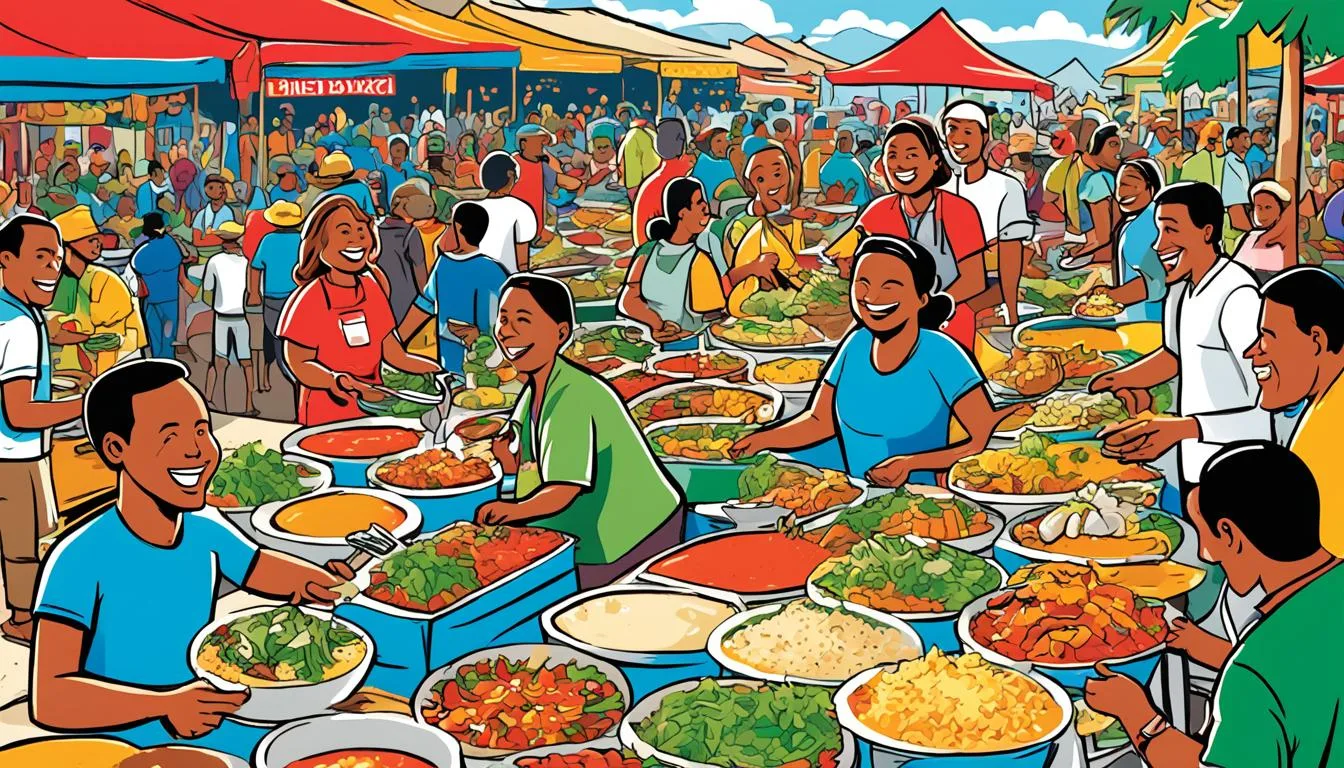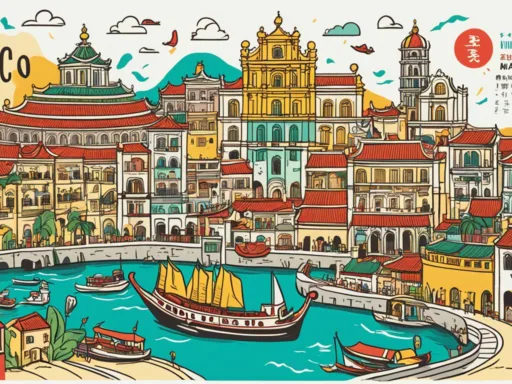Embark on a transcendent Culinary Journeys that will captivate your senses and challenge your perceptions of traditional gastronomy. Set sail through the flavors of an unsung culinary giant – Discovering Madagascar and its rich cuisine. Beyond the pristine beaches and luminescent waters lies a diverse world of diverse dishes waiting to be savored. Madagascar’s tapestry of flavors, punctuated with zesty spices and hearty staples, demands exploration. Offering more than meets the tongue, the island’s myriad treats are snapshots of its soul knit together by history and tradition.
Key Takeaways
- Madagascar’s culinary scene reflects its vibrant biodiversity and unique historical influences.
- The island’s cuisine features a rich interplay between Southeast Asian, African, Indian, and European flavors.
- Local fresh ingredients, including rice and a variety of laoka, play a central role in Malagasy dishes.
- From street stalls to upscale restaurants, each dining experience is a deep dive into Madagascar’s heritage.
- Madagascar’s rich cuisine is not just food; it’s a narrative of the island’s cultural mosaic and spirit.
- The island’s historical position as a major trading hub has made its cuisine a hotbed of diverse spices and cooking techniques.
Embarking on a Malagasy Cuisine Tour: An Introduction
Madagascar, an island teeming with flavor and spice, is an emerging destination for food enthusiasts eager to embark on a Malagasy Cuisine Tour. The island’s vibrant culinary scene offers a taste of the best local dishes, enriched by a history of international influence and abundant natural resources. In the bustling markets and tranquil villages, Madagascar waits to reveal its gastronomic secrets to those seeking an authentic Madagascar culinary experience.
As you travel through Madagascar, the aroma of local spices, such as vanilla, cloves, and cinnamon, fills the air. These treasured flavors form the heart of traditional recipes that you’ll experience on your journey. Coastal cities enchant visitors with a symphony of seafood delights, underpinning the tour’s promise to offer a diverse palette of tastes and aromas.
The base of many Malagasy meals is rice, a humble yet revered ingredient. A traditional meal often includes a variety of stews and side dishes, where each bite introduces another layer of the island’s culinary tapestry. To fully appreciate the breadth of this cuisine, consider the following sampler of Madagascar’s favorite dishes:
- Voanjobory sy Henakisoa (Bambara Pea with Pork)
- Ravitoto (Cassava Leaves with Pork or Beef)
- Mofo Gasy (Malagasy Bread)
- Romazava (Beef and Greens Stew)
- Masikita (Grilled Meats)
Envision a table laden with these delicacies, each offering a story about the land and its generous offerings. Your journey across this culinary landscape will engage more than just your taste buds; it will be a full sensory immersion into a culture rich with tradition and natural splendor.
| Local Dish | Main Ingredients | Flavor Profile |
|---|---|---|
| Voanjobory sy Henakisoa | Bambara peas, pork, tomatoes | Savory, hearty, with a hint of sweetness from the peas |
| Ravitoto | Cassava leaves, pork or beef, garlic | Rich, earthy, with a deep umami backdrop |
| Mofo Gasy | Flour, yeast, sugar | Sweet and slightly fermented |
| Romazava | Beef, mixed greens, ginger | Spicy, robust, infused with a gingery warmth |
| Masikita | Meats marinated in garlic and ginger | Charred, smoky, with a spicy kick |
Embark on a Malagasy Cuisine Tour and prepare for a journey not only across the island but through time itself. In each bite, the flavors of Madagascar speak to both the country’s past and its current tapestry of cultures, united in their love for hearty, soul-nurturing food. It’s a journey that invites you to share in the treasure of Madagascar’s culinary wealth.
The Roots of Madagascar Culinary Experience: A Historic Expedition
Embark on a culinary expedition that delves deep into the historical Madagascar and unravels the rich tapestry of Malagasy dishes. It’s a journey through time, where the traditional Malagasy food reflects a legacy of colonial trade and the mingling of international palates. The very essence of Madagascar’s gastronomy descends from a storied past of global influence and indigenous customs.

The Melting Pot of Colonial Influence
Over centuries, Madagascar has become a melting pot of flavors, where each wave of colonial influence left a distinct mark on its culinary identity. French cuisine brought butter, wine, and refined pastry techniques, marrying them with the island’s abundant offerings to exquisite effect. British, Arab, Indian, and Chinese migrants introduced their own iconic flavors and foods, enriching the Malagasy table with a cornucopia of tastes.
Trade Winds: Spices and Ingredients from Afar
With the breezes of trade winds came the spices that today typify Malagasy cooking. The introduction of cloves and cinnamon by African traders during the Bantu migrations created a bouquet of palatable aromas that became entrenched in the nation’s culinary repertoire. This confluence of distant cultures and local traditions gave rise to a unique blend of savors that beckons any food enthusiast on a historic voyage—one that tantalizes the taste buds and enriches the soul.
A Celebration of Local Malagasy Dishes: Coastal Treasures and Inland Delights
Madagascar’s food culture is a vibrant testament to the island’s love for local Malagasy dishes, each brimming with flavor and history. The coastal towns, with their proximity to the Indian Ocean, are havens for seafood enthusiasts, where fishermen haul in daily catches that chefs transform into mouthwatering traditional Malagasy meals.
Staples such as the ubiquitous fish curry, often laced with coconut, encapsulate the essence of the beachside food experience. Savor the richness of seafood transformed into delicate stews and curries, with spices that tingle the senses and fresh produce that brings the depths of the ocean to your plate. Undoubtedly, these dishes are engrained in Madagascar’s food culture, setting the scene for memorable dining experiences.
For those who journey inward to the elevated heartlands, the culinary landscape shifts dramatically. Here, the local Malagasy dishes are hearty and earthy, with the celebrated Romazava stew taking center stage. This dish, a medley of greens and meat, showcases the heartland’s robust offering, with Zebu meat—a local cattle breed—standing out for its bold flavors and satisfying succulence.
In Madagascar, eating is not merely a means to satiate hunger; it is a joyful exploration of flavors, a communal enterprise steeped in tradition and shared customs.
It’s at the bustling market stalls and quaint local eateries where the national ethos of shared meals—known as “fady”—permeate every dining experience. Here, tourists and locals alike indulge in a social culinary ritual, one that respects age-old taboos and rejoices in each new taste discovery. To fully experience the breadth of Madagascar’s food culture, one must delve into these traditional Malagasy meals, each telling a tale of the country’s multi-ethnic heritage and lush, vibrant terroir.
- Coastal Culinary Delights:
- Freshly Grilled Seafood
- Octopus Curry with Coconut
- Fish Soup with Local Spices
- Inland Gastronomic Treats:
- Romazava Stew
- Zebu Steak with Seasonal Vegetables
- Wild Boar in Pepper Sauce
- Communal Dining:
- Shared Platters of Varied Laoka
- Rice Dishes at the Heart of Every Meal
- Fady and its Role in Mealtime Harmony
Thus, a journey through Madagascar’s culinary landscape is one of connection and celebration, immersed in a rich food tradition that tantalizes the palate and warms the spirit.
The Essence of Traditional Malagasy Food: Key Ingredients and Preparations
Delving deep into the culture of Madagascar, one cannot overlook the significance and variety in traditional Malagasy food. This culinary tradition hinges on key Malagasy ingredients that come together to create authentic Malagasy recipes, each telling a story of the island’s rich and dynamic history.
The Staple of Rice in Malagasy Cuisine
Rice is not just a food item in Madagascar; it’s a cultural cornerstone. Integral to virtually every meal, it’s the culinary canvas upon which intricate flavors and textures are brought to life. The preparation of rice varies, from the simple boiled version called ‘vary sosoa’ to the elaborate ‘vary amin’anana’ where rice is cooked with greens and meat, showcasing its versatility and central role in Malagasy cuisine.
Leafy Greens and Legumes: Nutrient-Packed Components
Malagasy cuisine offers a diverse range of leafy greens and legumes, each adding essential nutrients and distinct flavors. Cassava leaves, known locally as ‘ravitoto,’ are often cooked with coconut or peanut sauce, revealing the Malagasy knack for creating dense, rich flavors. Legumes such as beans find their way into ‘tsaramaso malagasy,’ a dish that is both fulfilling and nutritional.
Proteins a Plenty: Seafood and Zebu Aplenty
Given Madagascar’s vast coastline, seafood is a prized component in Malagasy gastronomy. Fresh catches like Tilapia are cooked with ginger and garlic to create ‘Tilapia à la Malagasy,’ a sought-after dish among locals and visitors alike. Then there’s Zebu, the local breed of cattle, providing a unique flavor profile in dishes such as ‘romazava,’ a meaty, satisfying stew.
Together, these ingredients are not only staples in the Malagasy diet but also represent the country’s culinary identity—simple yet vibrant, with each ingredient imparting its own distinct characteristic to create a balanced and wholesome meal. The essence of traditional Malagasy food truly lies within these key components and their time-tested preparations.
Savoring the Best of Local Culinary Practices: Food Tour in Madagascar
Embark on a mesmerizing food tour in Madagascar and taste the essence of the island through its rustic Hotelys, bustling food markets, and polished fine dining venues. This culinary adventure offers a profound understanding of Malagasy gastronomy, from the heritage-rich best Malagasy dishes to the convenience and charm of Madagascar street food.
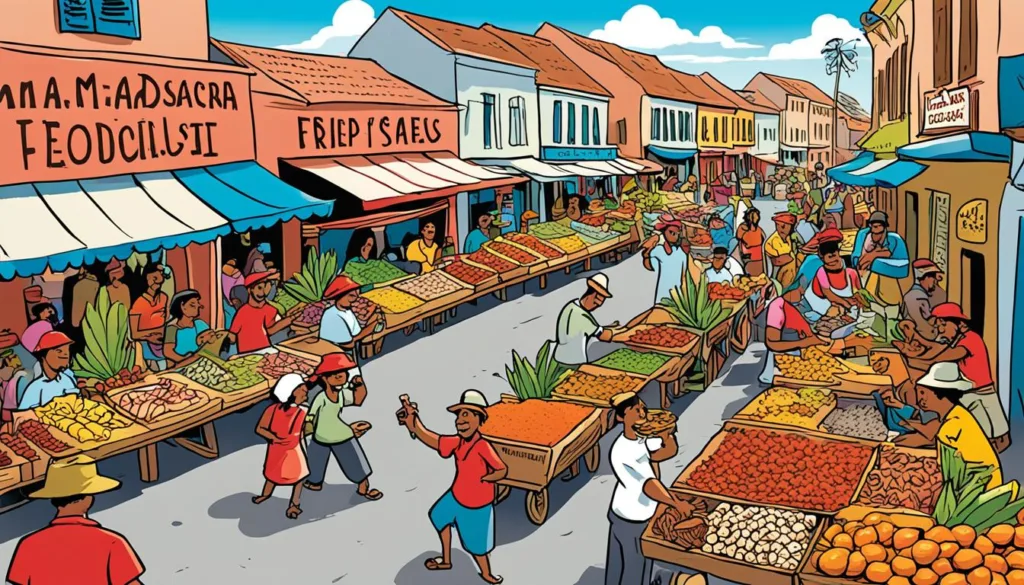
From Street Food to Fine Dining: A Spectrum of Flavors
Madagascar’s food scene is a vibrant tapestry woven with diverse culinary threads, each offering a unique flavor profile. The journey commences with street vendors whose selections can be as enjoyable as a gourmet meal. The intoxicating aroma of grilled meats, fresh samosas, and the beloved mofo gasy fill the air, ushering an authentic taste of everyday Malagasy life. Transitioning to a seated experience, upscale restaurants in Antananarivo captivate your senses with pristinely presented plates, innovating traditional recipes with a modern twist.
Hotelys and Roadside Stalls: Authentic Food Adventures
For a deep dive into local culinary culture, seek out the Hotelys and roadside stalls that dot the island. These establishments stand as testaments to Madagascar’s resources and the ingenious application of simple, fresh ingredients. Whether it’s a hearty plate of Romazava stew or flavorful sausages called saosisy, these places are the pinnacles of comfort food, offering a hospitable setting that feels like a second home. With each bite, savor the sustainable and resourceful spirit that defines the Malagasy culinary identity.
- Engage with locals over a shared meal of Voanjobory sy Henakisoa (Pork and Bambara Groundnut stew).
- Sample the varied flavors of homemade pickles, known locally as achards.
- Indulge in the sweet pleasures of Koba, a treat made with bananas, peanuts, and honey.
Madagascar is not just a place to eat; it’s a destination to experience a rich cultural exchange through the universal language of food. As you maneuver from street stalls to sit-down dinners, you translate the stories of an island steeped in tradition and innovation—one incredible meal at a time.
A Taste of Tradition: Sampling Authentic Malagasy Recipes
Embarking on a traditional Madagascar culinary tour is akin to stepping into a living cookbook, where ancient recipes narrate the island’s storied past through their robust flavors and aromatic spices. An encounter with authentic Malagasy recipes leads one through the untraveled alleys of Madagascar’s rich culinary heritage. Let’s explore a table laden with some of the best local Malagasy dishes that are must-tries for any gourmand.
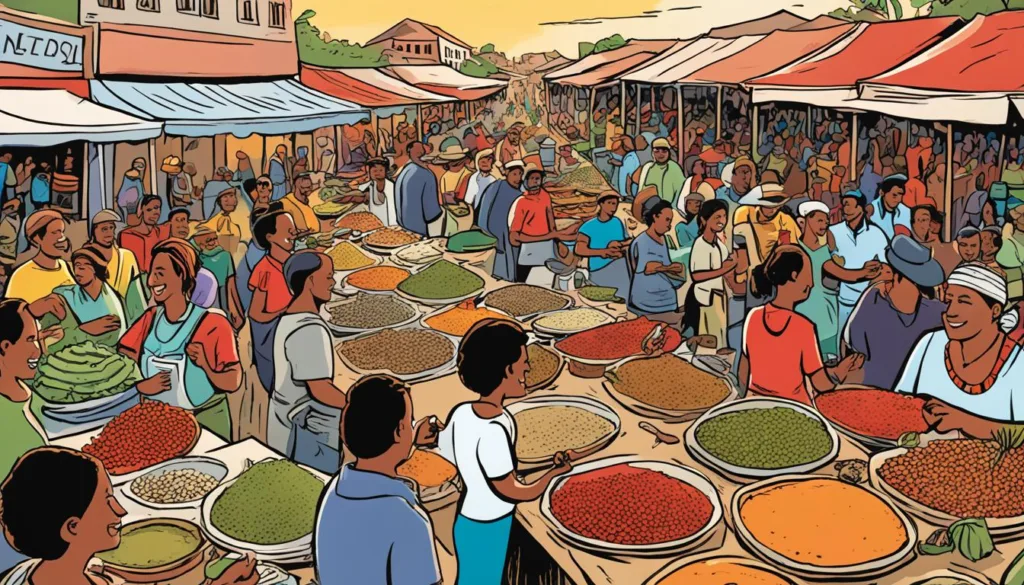
| Dish | Key Ingredients | Description |
|---|---|---|
| Romazava | Beef, leafy greens, onions, garlic | A hearty stew acknowledged as Madagascar’s national dish, balancing the richness of beef with the freshness of local greens. |
| Ravitoto | Pork, cassava leaves, coconut milk | A creamy concoction showcasing the velvety texture of cassava leaves cooked with succulent pieces of pork. |
| Mofo Anana | Bread, greens, tomatoes, onions | Translated as “bread with greens,” this dish combines the simplicity of baked goods with the zest of seasoned vegetables. |
| Vary Amin’anana | Rice, greens, meats or shrimps | An exemplary rice dish mixed with leafy greens and choices of protein, epitomizing the essence of Malagasy cuisine. |
Sampling these culinary treasures in their land of origin is more than a meal; it’s an immersive lesson in the socio-cultural etiquette of Madagascar. The dining experience is accentuated by the act of eating with one’s hands, sharing from communal plates which reflects the Malagasy spirit of kinship and togetherness.
“To eat is human, to eat well is divine.” – Ancient Malagasy Proverb
Indeed, to partake in Madagascar’s hospitality and to taste its genuine, unaltered flavors results in not just a satisfied palate, but a connection with the rich tapestry of traditions that is the essence of the island. A culinary journey through Madagascar, complete with its authentic Malagasy recipes, is a soulful tour of flavors waiting to enrapture the hearts of food enthusiasts worldwide.
Malagasy Cuisine Tasting: An Interactive Palate Pleaser
Embark on a flavorful journey through Madagascar’s rich culinary landscape, where the experience of Malagasy cuisine tasting serves not only as leisure but also as a cultural passage. The satisfaction derived from this interactive engagement with diverse Malagasy flavors extends beyond the taste buds, fostering a deeper appreciation of Madagascar’s vibrant social heritage.
From Tangy to Sweet: The Multifaceted Taste Palette
Madagascar’s culinary repertoire is a testament to its diverse flora and fauna. Tantalizing the palate with a spectrum of tastes ranging from the tanginess of pickled vegetables, known as achard, to the sweetness of natural desserts like mofo akondro, Malagasy cuisine tasting invites one into a world of rich, layered flavors that are as complex as the island’s ecosystem.
Community Feasts: Dining as a Cultural Exchange
Community feasts stand as a hallmark of Madagascar’s communal culture. These gatherings, whether woven into the social fabric of everyday life or celebrated during events like a traditional moraingy wrestling match, become much more than just meals. They are a collective experience in which sharing food equates to sharing life, strengthening communal ties, and ensuring the endurance of a rich cultural tradition.
| Dish | Ingredients | Flavor Profile | Origin |
|---|---|---|---|
| Achard | Pickled vegetables, vinegar, spices | Tangy, spicy | Influenced by Indian cuisine |
| Ravitoto | Cassava leaves, pork | Hearty, rich | Traditional Malagasy |
| Mofo Akondro | Bananas, flour, sugar | Sweet, crispy | Traditional Malagasy |
| Lasary | Vegetables, turmeric, mustard seeds | Tangy, refreshing | Inspired by regional tastes |
Through the lens of these gastronomical creations, one’s palate becomes a canvas, capturing the essence of Madagascar – each dish telling a story, each bite connecting the diner to the generations that perfected these flavors. Indeed, a Malagasy cuisine tasting is more than mere consumption; it is participation in a legacy that continues to flavor the very heart of this island nation.
Flavors that Endure: The Best Malagasy Dishes to Remember
Madagascar’s rich culinary heritage gifts its visitors with best Malagasy dishes that offer a taste of the island’s vibrant culture and history. These Malagasy dish highlights are not just sustenance but a journey into the heart of Madagascar’s traditions and the soul of its people. Two dishes, in particular, stand out for their complex flavors and heartfelt comfort.
Dish Highlights: Romazava
Romazava, undoubtedly one of Madagascar’s finest, is a beloved stew that showcases the culinary prowess of combining beef with an assortment of leafy greens. This national dish is cooked slowly, allowing the rich flavors of the meats and herbs to meld together harmoniously. Romazava reflects Madagascar’s simple, yet profound cooking philosophy: to create memorable meals with whatever the land generously offers.
Must-Try: Ravitoto with Pork
No culinary exploration is complete without the savoring of Ravitoto with pork. This iconic dish combines the earthy tones of ground cassava leaves with the savory depth of pork, embodying Madagascar’s creative utilization of local ingredients. As a cultural staple, it resonates with anyone seeking the authentic flavors of the island.
Exotic Treats: Koba and Mofo Akondro
For those with a sweet tooth, the exotic treats of Madagascar hold captivating indulgences. Koba, a unique and hearty treat composed of bananas and peanuts, offers a sweet and savory profile wrapped in a banana leaf. The fried banana fritters known as Mofo Akondro provide an irresistible crunch, rounding off any meal with a golden, sugary finish. These treats are a delightful testament to Madagascar’s generous palette of flavors.
Whether it’s the heartiness of a stew or the sweet bite of a fritter, Madagascar’s cuisine is a treasure trove for the gastronomes looking to expand their culinary horizons with the best Malagasy dishes. These dishes stand as culinary beacons, ensuring that every bite taken is etched into memory, echoing the exotic allure of Madagascar long after the journey ends.
Conclusion
As we wrap up our Culinary journey in Madagascar, it’s evident that every bite we have savored acts as a narrative thread weaving through the island’s vibrant history and cultures. Those embarking on a Malagasy Cuisine Tour are not merely indulging in sumptuous dishes; they are partaking in a storied ritual that brings together the traditions of the past with the innovation of present-day chefs. This journey transcends the act of eating, representing a heartfelt expedition through Madagascar’s diverse and bountiful landscapes.
Madagascar’s rich food tapestry reveals layers of influences that mirror the island’s multifaceted heritage. From the smallest grain of aromatic rice to the expansive variety of hearty laoka stews, a Malagasy meal is a celebration of flavors, community, and life itself. It is through this kaleidoscopic culinary lens that we gain insights into a culture that is as sumptuous as the dishes it shares. Indeed, Madagascar’s food journey is a passport to understanding the soul of this unique island nation.
Your encounters with the Malagasy cuisine are likely to linger long after the meals have ended, each recipe narrating a unique story of its own. As memories of fragrant spices and rich flavors dwell in the minds of culinary adventurers, they carry away a piece of Madagascar’s essence. The shared meals, the markets bustling with fresh produce, and the serene beauty of the island itself, all contribute to an unforgettable voyage that extends far beyond mere gastronomy. It’s a vibrant, edible tapestry — as unforgettable as the majestic landscapes of Madagascar.
